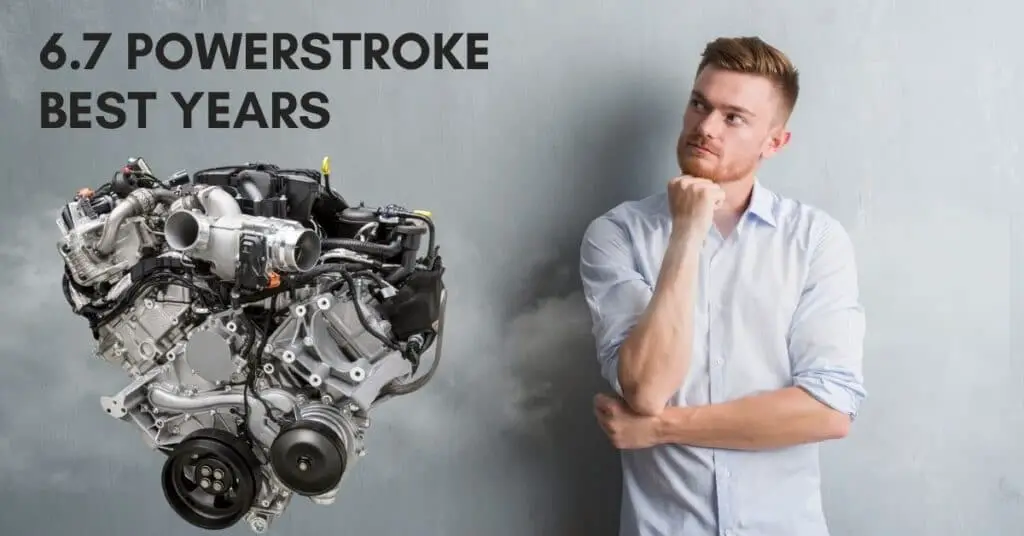While the 2011 6.7 Powerstroke reliability cannot be questioned, this early version of the engine had several issues that cannot be ignored. The first generation of Ford 6.7 Powerstroke starts from 2011 to 2014. At this time being the produced engine was mainly suffering these problems which are:
- Exhaust Valve Breaking Issue
- Ceramic Turbocharger Problem
- EGT sensor Failure
- EGR Cooling Issue
- Glow Plug issue And so on
Thankfully, ford has addressed some of these issues in the later generations of the engine over the years. So which Which Are The Best Year For 6.7 Powerstroke year?
Best Year For 6.7 Powerstroke year?
Well, I would say the later years starting from 2015 onwards. The 2015 -2019 version addressed many of the issues of the first-generation engine. For starters, the second-generation engine comes with a larger turbocharger.

Let’s take a look at the two generations that succeeded the problematic first generation of the 6.7L engine. These two generations offer the best version of the 6.7L engine and are the best years of the engine.
The 2nd Generation Of 6.7 Powerstroke: 2015-2019
The second generation introduced several changes that made the engine much better compared to the first generation. Some notable changes were introduced in the 2nd generation of the 6.7L that were aimed at improving the performance and resolving the problems of its predecessors. These upgrades were;
What Are The Upgrades Made In the 2nd Generation Of 6.7 Powerstroke Than 1st Generation?
Turbocharger Replacement
The 2011-2014 6.7L engines used a single sequential SST turbocharger that was relatively small and was prone to failure. To resolve this, ford replaced it with a Garrett GT37 turbocharger in the 2015-2019 models.
This new turbocharger offers improved performance at high altitudes and exhaust braking. Also, it is less prone to failure than the previous SST turbocharger. However, if you own a 6.7 Powerstroke before 2014 you can opt for the 6.7 powerstroke turbo upgrade available in the market.
Improved Cp4 pump
The cp4 pump in the second generation engines was also improved, adding more fuel flow—this increase in fuel flow results in higher horsepower and torque. Also, the pump seems not to have the problems of its predecessor.
Cylinder Head
The second-generation engine also comes with a new cylinder head made from cast aluminum. Moreover, the cylinder head is of better quality than that found in earlier versions of the engine.
3rd Generation Of 6.7 Powerstroke: 2020-onward
While the 2015-2019 generation of engines solved many of the problems of the first generation, it lags behind the new post-2020 6.7L engines in terms of performance. Nevertheless, these more recent engines are the best out of the three generations of the engine.
Now, Let’s take a look at some of the things that makes these newer engines better than their predecessors.
Things That Upgrades In 3rd Generation Powerstroke Than 2nd and 1st Generation?
The new fuel injection system
Ford did away with the fuel injection system of the older 6.7L engines and opted for a completely new system. The new system still utilizes a lift pump to the cp4 pump. The new injectors are capable of up to 8 injections per cycle.
This is a significant upgrade from the around 5 injections per cycle of the older models. In addition, this upgrade makes the engine quieter than the older models. The new system is also able to handle a higher pressure of 36,000 PSI.
This is compared to the 30,000 PSI that the older 6.7L engines can handle. The result of this is improved horsepower and torque. The 2020 6.7L engines are capable of an impressive 475 HP and a massive 1050 lb-ft of torque.
Steel pistons, revised cylinder heads, and intake manifold
Another notable change is the replacement of the aluminum pistons in the 15-19 engines with new steel pistons. Given that steel is a heavier metal, the new pistons are also shorter than those on the previous models.
The shorter profile of the pistons means less friction. Also, the new pistons are stronger and more resilient than the previous aluminum ones. It also comes with revised cylinder heads.
But most notably, the engine comes with a new aluminum intake manifold, which is better than the plastic manifold we got on the 15-19 and 11-14 generations.
New VGT turbocharger
The turbocharger has also been overhauled, and the 2020 engine comes with an electronically actuated VGT turbocharger. This is in contrast to the oil pressure-based turbocharger of the previous models.
This change translates to improved responsiveness and does also has an effect on the engine’s emissions. So you can expect lower emissions than the previous models. The only concern here is that the turbocharger is smaller compared to that on the 15-19 models.
This may not be a big problem, though, but it is something to keep note especially if you plan on towing heavy loads.
New 10-speed transmission
The engine comes with a new 10-speed automatic transmission to replace the 6-speed transmission of the 15-19 generation. The new transmission offers a wider gear ratio and comes with five different drive modes. These modes include normal, tow/haul, eco, slippery and deep sand, and snow.
My Final Thought
So which is the best 6.7 Powerstroke year? Well, 2017 engines and above offer improved reliability and will be a good choice for anyone. As for the 2020 engine, it does feature some significant improvements that make it a better engine.
In terms of performance, the 2020 engine is undoubtedly the best. However, new trucks with the 2020 engine can be costly. Thus if money is an issue for you, consider the 2017, 2018, or 2019 version of the 6.7 Powerstroke truck.
However, if money isn’t an issue and you want to tow heavier loads, the 2020 engine will be the best choice.
Last Updated on August 29, 2025 by Rifen
